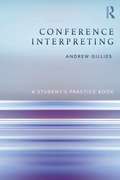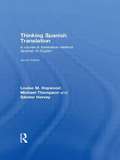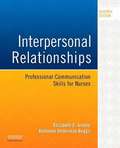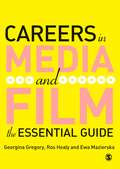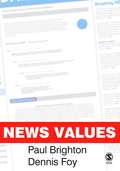- Table View
- List View
Column Layout Examples (large print)
by RnibThis diagram shows examples of three of the many column layouts that might be used in a print publication. There is a locator dot shown, which will be at the top left of the page when the image is the right way up. There are descriptive labels on the left of the page and layout examples on the right. In each example, the horizontal lines texture indicates areas of body text, and the fine dotted textured areas represent columns that might be used for headings, annotations, a table of contents, pull quotes, images, advertisements or even left empty to give the page an uncluttered look. Each example shows a single page.
Central Processing Unit (CPU) (UEB uncontracted)
by RnibThis flowchart diagram shows the features of a computer central processing unit with input, output and backing store. The CPU, shown by a textured rectangle, is in the centre of the page. Inside this are three unfilled rectangles representing, from the top to bottom, the control unit, the arithmetic and logic unit, and the immediate access store. Linked by arrows to the CPU are three rectangular boxes. Input is to the left, output to the right and backing store at the bottom of the page.
Central Processing Unit (CPU) (UEB contracted)
by RnibThis flowchart diagram shows the features of a computer central processing unit with input, output and backing store. The CPU, shown by a textured rectangle, is in the centre of the page. Inside this are three unfilled rectangles representing, from the top to bottom, the control unit, the arithmetic and logic unit, and the immediate access store. Linked by arrows to the CPU are three rectangular boxes. Input is to the left, output to the right and backing store at the bottom of the page.
Bridge Connection (tactile)
by RnibThis diagram shows a bridge connection between two rows of computers. The computers are textured shapes with "computer" labels; the lines coming from them are connecting cables.
Central Processing Unit (CPU) (large print)
by RnibThis flowchart diagram shows the features of a computer central processing unit with input, output and backing store. The CPU, shown by a textured rectangle, is in the centre of the page. Inside this are three unfilled rectangles representing, from the top to bottom, the control unit, the arithmetic and logic unit, and the immediate access store. Linked by arrows to the CPU are three rectangular boxes. Input is to the left, output to the right and backing store at the bottom of the page.
Carrier Sense Multiple Access (tactile)
by RnibThis diagram shows a carrier sense multiple access network.
Binary Tree (tactile)
by RnibThis diagram shows a binary tree with labels on the different components.
Base Register Addressing (tactile)
by RnibThis is a diagram showing base register addressing. There are two textured boxes on the right, the top labelled operand and the bottom labelled bass register. These are connected with to a circle in the centre of the page with a "+" label within. This circle is connected to a large textured box on the right labelled memory, this box is split into multiple sections, one of them labelled data.
Interpreting and Translating in Public Service Settings
by Raquel De Pedro Ricoy Isabelle Perez Christine W. L. WilsonTranslation, interpreting and other forms of communication support within public sector settings constitute a field which deals, quite literally, with matters of life and death. Overshadowed for many years by interpreting and translating in other domains, public sector interpreting and translating has received growing attention in recent years, with increasingly mobile populations and human rights, diversity and equality legislation shining the spotlight on the need for quality provision across an increasing range and volume of activities. Interpreting and Translating in Public Service Settingsoffers a collection of analytically-grounded essays that provide new insights into the reality of the interaction in public sector settings and into the roles and positioning of the participants by challenging existing models and paradigms. Issues of local need, but with global resonance, are addressed, and current reality is set against plans for the future. The triad of participants (interpreter/translator, public sector professional and client) is investigated, as are aspects of pedagogy, policy and practice. Empirical data supports the study of topics related to written, spoken and signed activities in a variety of professional settings. Bringing together academics and practitioners from different countries in order to explore the multidisciplinary dimension of the subject, this collection should serve as a valuable reference tool, not only for academics and students of public sector interpreting and translating, but also for practising linguists, providers of language services and policy makers. 9781317641568
Conference Interpreting
by Andrew GilliesConference Interpreting: A Student's Practice Bookbrings together a comprehensive compilation of tried and tested practical exercises which hone the sub-skills that make up successful conference interpreting Unique in its exclusively practical focus, Conference Interpreting: A Student's Practice Book, serves as a reference for students and teachers seeking to solve specific interpreting-related difficulties. By breaking down the necessary skills and linking these to the most relevant and effective exercises students can target their areas of weakness and work more efficiently towards greater interpreting competence. Split into four parts, this Practice Book includes a detailed introduction offering general principles for effective practice drawn from the author's own extensive experience as an interpreter and interpreter-trainer. The second 'language' section covers language enhancement at this very high level, an area that standard language courses and textbooks are unable to deal with. The last two sections cover the key sub-skills needed to effectively handle the two components of conference interpreting; simultaneous and consecutive interpreting. Conference Interpreting: A Student's Practice Bookis non language-specific and as such is an essential resource for all interpreting students regardless of their language combination. 9780203114926 9780415532341 9781136293191
Conference Interpreting (PDF)
by Andrew GilliesConference Interpreting: A Student's Practice Bookbrings together a comprehensive compilation of tried and tested practical exercises which hone the sub-skills that make up successful conference interpreting Unique in its exclusively practical focus, Conference Interpreting: A Student's Practice Book, serves as a reference for students and teachers seeking to solve specific interpreting-related difficulties. By breaking down the necessary skills and linking these to the most relevant and effective exercises students can target their areas of weakness and work more efficiently towards greater interpreting competence. Split into four parts, this Practice Book includes a detailed introduction offering general principles for effective practice drawn from the author's own extensive experience as an interpreter and interpreter-trainer. The second 'language' section covers language enhancement at this very high level, an area that standard language courses and textbooks are unable to deal with. The last two sections cover the key sub-skills needed to effectively handle the two components of conference interpreting; simultaneous and consecutive interpreting. Conference Interpreting: A Student's Practice Bookis non language-specific and as such is an essential resource for all interpreting students regardless of their language combination. 9780203114926 9780415532341 9781136293191
Thinking Spanish Translation: Spanish to English (PDF)
by Louise Haywood Sándor Hervey Michael ThompsonThe new edition of this comprehensive course in Spanish-English translation offers advanced students of Spanish a challenging yet practical approach to the acquisition of translation skills, with clear explanations of the theoretical issues involved. A variety of translation issues are addressed, including: cultural differences register and dialect grammatical differences genre. With a sharper focus, clearer definitions and an increased emphasis on up-to-date 'real world' translation tasks, this second edition features a wealth of relevant illustrative material taken from a wide range of sources, both Latin American and Spanish, including: technical, scientific and legal texts journalistic and informative texts literary and dramatic texts. Each chapter includes suggestions for classroom discussion and a set of practical exercises designed to explore issues and consolidate skills. Model translations, notes and suggestions for teaching and assessment are provided in a Teachers' Handbook; this is available for free download at http://www. routledge. com/cw/thinkingtranslation/ Thinking Spanish Translationis essential reading for advanced undergraduate and postgraduate students of Spanish and translation studies. The book will also appeal to a wide range of language students and tutors through the general discussion of the principles and purposes of translation. 9781134070183 9780415481304 9780203886014 9780415440042
Thinking Spanish Translation: Spanish to English
by Louise Haywood Sándor Hervey Michael ThompsonThe new edition of this comprehensive course in Spanish-English translation offers advanced students of Spanish a challenging yet practical approach to the acquisition of translation skills, with clear explanations of the theoretical issues involved. A variety of translation issues are addressed, including: cultural differences register and dialect grammatical differences genre. With a sharper focus, clearer definitions and an increased emphasis on up-to-date 'real world' translation tasks, this second edition features a wealth of relevant illustrative material taken from a wide range of sources, both Latin American and Spanish, including: technical, scientific and legal texts journalistic and informative texts literary and dramatic texts. Each chapter includes suggestions for classroom discussion and a set of practical exercises designed to explore issues and consolidate skills. Model translations, notes and suggestions for teaching and assessment are provided in a Teachers' Handbook; this is available for free download at http://www. routledge. com/cw/thinkingtranslation/ Thinking Spanish Translationis essential reading for advanced undergraduate and postgraduate students of Spanish and translation studies. The book will also appeal to a wide range of language students and tutors through the general discussion of the principles and purposes of translation. 9781134070183 9780415481304 9780203886014 9780415440042
Introducing Translation Studies: Theories and Applications (PDF)
by Jeremy MundayThis introductory textbook provides an accessible overview of the key contributions to translation theory. Munday explores each theory chapter-by-chapter and tests the different approaches by applying them to texts. The texts discussed are taken from a broad range of languages - English, French, German, Spanish, Italian, Punjabi, Portuguese and Spanish - and English translations are provided. A wide variety of text types is analysed, including a tourist brochure, a children's cookery book, a Harry Potter novel, the Bible, literary reviews and translators' prefaces, film translation, a technical text and a European Parliament speech. Each chapter includes the following features: * a table introducing key concepts * an introduction outlining the translation theory or theories * illustrative texts with translations * a chapter summary * discussion points and exercises. Including a general introduction, an extensive bibliography, and websites for further information, this is a practical, user-friendly textbook that gives a balanced and comprehensive insight into translation studies. 9780415396943 9780415396936 9780203869734 9780415229265
Becoming a Translator: An Introduction to the Theory and Practice of Translation
by Douglas RobinsonFusing translation theory with advice and information about the practicalities of translating, Becoming a Translator is an essential resource for novice and practising translators. The book helps students learn how to translate faster and more accurately, how to deal with potential problems, including dealing with stress and how the market works. This second edition has been revised throughout, and includes an exploration of new technologies used by translators and a 'Useful Contacts' section including the names, addresses and web addresses of translator organizations, training programmes, journals and translator agencies. Exercises, email exchanges and examples have also been updated throughout. Becoming a Translator is an invaluable guide for all aspiring and practising translators. 9780415300322 9780203425961
Becoming a Translator: An Introduction to the Theory and Practice of Translation (PDF)
by Douglas RobinsonFusing translation theory with advice and information about the practicalities of translating, Becoming a Translator is an essential resource for novice and practising translators. The book helps students learn how to translate faster and more accurately, how to deal with potential problems, including dealing with stress and how the market works. This second edition has been revised throughout, and includes an exploration of new technologies used by translators and a 'Useful Contacts' section including the names, addresses and web addresses of translator organizations, training programmes, journals and translator agencies. Exercises, email exchanges and examples have also been updated throughout. Becoming a Translator is an invaluable guide for all aspiring and practising translators. 9780415300322 9780203425961
Corporate Communication: A Guide to Theory and Practice (PDF)
by Professor Joep P. CornelissenWritten specifically for students interested in knowing more about the organizational and management context of communications, and to get more hands-on learning, practical experience and skills to help them get off to a flying start in their career, this book is a guide to corporate communication that will help students and practitioners navigate the area, understand the main theories and put these into practice through examples and case studies. Academically grounded, it covers the key concepts, principles and models within corporate communication by bringing together academic knowledge and insights from the subject areas of management and communication. At the same time, it combines this academic base with a clear practical outlook – practical cases illustrate the theory and each chapter also focuses on models and exercises that equip students with practical expertise and skills. The international scope of the book, featuring cases from around the globe has been instrumental in its success and has now been used by nearly 20,000 students across over 50 different countries from New York to Helsinki, Tokyo to Rio de Janeiro for students studying Corporate Communication, Organizational Communication, PR and Marketing Communications and as an invaluable source for reflective practitioners. The new fourth edition has been revised and updated with new cases and covers developments is areas such as reputation management, leadership communication and CSR communication. It features: A new chapter on social media and increased coverage of new media in existing chapters New up-to-date material on emerging CSR standards, transnational governance and corporate citizenship Extended focus on media relations, internal communications and leadership and change communication New full-length and shorter international case studies Enhanced companion website material including new case studies and video material available on publication at www.sagepub.co.uk/cornelissen4e
The Dynamics Of Persuasion: Communication And Attitudes In The 21st Century
by Richard M. PerloffWith substantial revisions reflecting new research and changes in society, the fifth edition of The Dynamics of Persuasionintroduces students to major theories of persuasion and attitudes, using theory as the key to unlock the mysteries of contemporary social influence. Organized in terms of major concepts, issues, and persuasion contexts, the book offers a lucid introduction to the body of scholarly knowledge on persuasion, up-to-date examples of persuasion in real life, and a thorough discussion of the ethics of persuasion in contemporary society. This package includes a free one-year subscription to an enhanced Interactive eTextbook, complete with author-narrated chapter synopses, videos, exercises, flashcards, and more resources for instructors and students. Key features of the interactive e-textbook: * Anytime, anywhere access via VitalSource's Bookshelf; the most used eTextbook platform in the world * End-of-chapter interactive exercises; multiple-choice exercises to encourage students to test their understanding of the key concepts * Audio chapter introductions from the author * Note taking and sharing functionalities * Clickable definitions for key terms * Hyperlinked further reading with links to key websites selected by the author * A full color version of the text. Available Instructor Resources: * An instructor manual * An image bank drawn from the text * A video playlist with complementary discussion questions * Chapter-by-chapter slides which instructors can adapt and integrate with their teaching * Web links to useful websites and further reading Visit RoutledgeInteractive. comwhere instructors can register to access the instructor resources for free.
The Dynamics Of Persuasion: Communication And Attitudes In The 21st Century (PDF)
by Richard M. PerloffWith substantial revisions reflecting new research and changes in society, the fifth edition of The Dynamics of Persuasionintroduces students to major theories of persuasion and attitudes, using theory as the key to unlock the mysteries of contemporary social influence. Organized in terms of major concepts, issues, and persuasion contexts, the book offers a lucid introduction to the body of scholarly knowledge on persuasion, up-to-date examples of persuasion in real life, and a thorough discussion of the ethics of persuasion in contemporary society. This package includes a free one-year subscription to an enhanced Interactive eTextbook, complete with author-narrated chapter synopses, videos, exercises, flashcards, and more resources for instructors and students. Key features of the interactive e-textbook: * Anytime, anywhere access via VitalSource's Bookshelf; the most used eTextbook platform in the world * End-of-chapter interactive exercises; multiple-choice exercises to encourage students to test their understanding of the key concepts * Audio chapter introductions from the author * Note taking and sharing functionalities * Clickable definitions for key terms * Hyperlinked further reading with links to key websites selected by the author * A full color version of the text. Available Instructor Resources: * An instructor manual * An image bank drawn from the text * A video playlist with complementary discussion questions * Chapter-by-chapter slides which instructors can adapt and integrate with their teaching * Web links to useful websites and further reading Visit RoutledgeInteractive. comwhere instructors can register to access the instructor resources for free.
Interpersonal Relationships: Professional Communication Skills For Nurses (PDF)
by Elizabeth C. Arnold Kathleen Underman BoggsEffective communication with clients, families, and professional colleagues starts here! With Interpersonal Relationships: Professional Communication Skills for Nurses, 7th Edition, you'll see how good communication skills can lead to achieving treatment goals in health care. Clear guidelines show how you can enhance the nurse-client relationship through proven communication strategies as well as principles drawn from nursing, psychology, and related theoretical frameworks. And you'll see how to apply theory to real-life practice with case studies, interactive exercises, and evidence-based practice studies. A two-time winner of the AJN Book of the Year award, this book is updated to emphasize interdisciplinary communication and QSEN competencies. From expert nursing educators Elizabeth Arnold and Kathleen Underman Boggs, this comprehensive, market-leading text is unmatched for helping nurses develop effective communication skills! Interactive exercises offer the opportunity to practice, observe, and critically evaluate your professional communication skills in a safe learning environment. Practical guidelines describe how to modify communications strategies for various populations and situations including children, the elderly, end of life, clients with special needs, health teaching, stress, crisis, and professional colleagues. Case examples help you develop empathy for clients' perspectives and needs. Nursing, behavioral, developmental, family, and communication theories provide an essential foundation and a theoretical perspective for effective communication. Learning objectives, chapter overviews, and a detailed glossary focus your study and help you absorb and retain key content. NEW! A greater emphasis on communication, interdisciplinary theory, and interprofessionalism includes a focus on the nursing paradigm, nursing discipline, and ways of knowing. NEW! Focus on QSEN competencies reflects current thinking on technology, safety, and evidence-based practice, especially as they relate to communication in nursing. NEW! Discussion questions at the end of each chapter encourage critical thinking. NEW! Clarity and Safety in Communication chapter addresses topics such as huddles, rounds, handoffs, SBAR, and other forms of communication in health care.
Rethinking the Media Audience: The New Agenda (PDF)
by Dr Pertti AlasuutariPertti Alasuutari provides a state-of-the-art summary of the field of audience research. With contributions from Ann Gray, Joke Hermes, John Tulloch and David Morley, a case is presented for a new agenda to account for the role of the media in everyday life.
Globalization, Development and the Mass Media (PDF)
by Colin SparksGlobalization, Development and the Mass Media gives a comprehensive and critical account of the theoretical changes in communication studies from the early theories of development communication through to the contemporary critiques of globalization. It examines two main currents of thought. Firstly, the ways in which the media can be used to effect change and development. It traces the evolution of thinking from attempts to spread 'modernity' by way of using the media through to alternative perspectives based on encouraging participation in development communication. Secondly, the elaboration of the theory of media imperialism, the criticisms that it provoked and its replacement as the dominant theory of international communication by globalization.
Careers in Media and Film: The Essential Guide (PDF)
by Ms Ros J Healy Georgina Gregory Ewa MazierksaWritten for students, graduates and academics from the disciplines of film, media and related subjects, and for those from other disciplines who want to break into the media, this book is a virtual career coach and an employability course all in one package. A practical handbook, it offers encouragement, advice, information and case studies to help students to make the most of the opportunities in this very competitive career world. The book can be used as a textual support for careers modules and PDP (Personal Development Planning), graduate workshops, on-line courses and as a departmental or careers library resource. Equally, it works effectively as a self-help guide to enable individuals to focus on their career / life development.
News Values (PDF)
by Paul Brighton Dennis FoyWritten by two practitioner-academics (who between them have more than fifty years of news industry experience), News Values analyses the shape of the news industry - a world of rolling news and multimedia platforms, and a world where broadcast news is increasingly considered another element of show business. Detailed chapters include critiques of existing theories, close study of the newspaper, radio, television and internet news channels, plus informative chapters on the many factors that shape the news we read, watch and hear including the role of the citizen journalist, user-generated content, spin doctors, and the new wave of press barons. Further chapters provide detailed analysis of the way in which the same story is treated across different media channels, and how journalists and editors work to keep breathing new life into rolling news stories.


